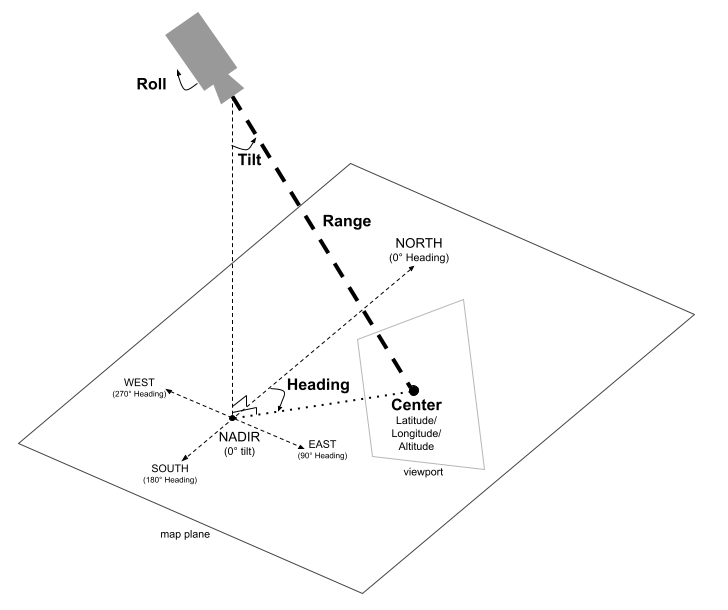يمكن للمستخدمين التحكّم في التكبير أو التصغير والإمالة والموضع والتدوير للكاميرا باستخدام الإيماءات على الخريطة. يمكنك أيضًا ضبط إعدادات الكاميرا آليًا.

موضع الكاميرا
يتم تصميم عرض الخريطة على شكل كاميرا تنظر إلى نقطة معيّنة في مساحة ثلاثية الأبعاد. يتم تحديد موضع الكاميرا واتجاهها (وبالتالي عرض الخريطة) من خلال الخصائص التالية: المركز (موقع جغرافي يضم خطوط الطول والعرض والارتفاع الذي تنظر إليه الكاميرا)، والاتجاه، والميل، والمدى، والانحراف.
المركز (خط العرض/خط الطول/الارتفاع)
يحدّد المركز النقطة المحدّدة في المساحة الثلاثية الأبعاد التي تراقبها الكاميرا. يتم تحديدها باستخدام قيم خطوط الطول والعرض والارتفاع. يتيح ذلك تحديد موضع دقيق لنقطة تركيز الكاميرا في ثلاثة أبعاد.
يمكن أن يتراوح خط العرض بين 90- و90 درجة، مع تضمين القيمتين. سيتم تقريب أي قيم خارج هذا النطاق إلى أقرب قيمة ضمنه. على سبيل المثال، سيؤدي تحديد خط عرض بقيمة 100 إلى ضبط القيمة على 90. يتراوح خط الطول بين 180- و180 درجة، بما في ذلك. يتم تحديد الارتفاع بالأمتار فوق مستوى سطح البحر.
العنوان
تحدّد جهة الكاميرا الاتجاه الذي ستتّخذه الكاميرا، ويتم قياسه بالدرجات في اتجاه عقارب الساعة من الشمال الحقيقي. يتوافق الشمال مع 0 درجة، والشرق مع 90 درجة، والجنوب مع 180 درجة، والغرب مع 270 درجة. يحدّد هذا الخيار اتجاه الكاميرا حول نقطة المنتصف على المحور العمودي.
الإمالة
تحدّد زاوية الإمالة زاوية الكاميرا بالنسبة إلى المحور الرأسي، ويتم قياسها بالدرجات. تعني زاوية الميل البالغة 0 درجة أنّ الكاميرا موجّهة للأسفل مباشرةً نحو الأرض (نقطة سمت القدم). يعني الميلان بزاوية 90 درجة أنّ الكاميرا موجّهة أفقيًا في الاتجاه المحدّد بواسطة الاتجاه.
النطاق
يحدّد النطاق المسافة بالأمتار بين موضع الكاميرا والنقطة المركزية التي تتّجه إليها. يمكن أن يتراوح النطاق من صفر متر (لقطات مقرّبة جدًا) إلى ثلاثة وستين مليون متر، ما يتيح إمكانية عرض اللقطات من مسافة قريبة جدًا إلى منظور عالمي حقيقي. يتحكّم هذا الإعداد بشكل فعّال في مستوى تكبير الخريطة أو تصغيرها.
الدوران
تحدّد قيمة الدوران زاوية الكاميرا بالنسبة إلى الأفق، ويتم قياسها بالدرجات. يمكن استخدام هذه المَعلمة لإنشاء تأثيرات مثل الميلان أثناء محاكاة الطيران أو حتى الدوران الكامل، وذلك بتدوير الكاميرا حول محور العرض.
التحكّم في الكاميرا
يوضّح نموذج الرمز البرمجي التالي كيفية التحكّم في الكاميرا آليًا.
Swift
public static var sanFrancisco: Camera = .init( latitude: 37.7845812, longitude: -122.3660241, altitude: 585, heading: 288.0, tilt: 75.0, roll: 0.0, range: 100)

